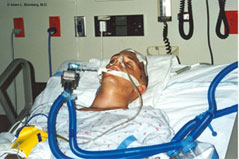
 |
When he was 18, he was thrown 39 feet, 8 inches, from a minivan and crashed on his head. His skull was fractured, his lung collapsed. EMS rushed the comatose Blomberg into an emergency room as a ``possible fatality.'' Doctors asked his mother if he had signed a donor transplant card. But he clung to life. A week later, he ''woke'' up from his coma, determined to craft a new life, despite a rigorous rehab that included teaching his brain how to learn again. ''I survived for a reason,'' says Blomberg, 27, who will graduate this month from the University of Miami Medical School, nine years after his accident. His mission: To become an anesthesiologist and to teach young people about the dangers of riding without a seat belt. ''I feel it is my calling to talk about safe driving,'' he says. As such, he produced a multimedia injury prevention and education program -- dubbed Adam -- A Survivor's Story. Two years ago, the Health Foundation of South Florida gave the UM School of Medicine's William Lehman Injury Research Center $55,000 to expand the program. The grant allowed him to speak at more schools about road rage, drunken driving and the need to use safety belts. He also made a CD-rom presentation -- which includes another crash victim's survival story. After making 60 to 70 presentations -- sometimes as many as three a month -- Blomberg now has a waiting list for his talks. Dr. Priscilla Potter, a UM School of Medicine assistant professor and assistant dean for curriculum, says Blomberg's talks are needed to persuade kids to buckle up. ''If you are not wearing a safety belt,'' she says, ``you're just a projectile.'' Blomberg talks frankly with the kids, dispersing rapid-fire stats: Motor vehicle deaths are the No. 1 cause for teens' deaths -- and crashes involving teens not wearing seat belts have the highest percentages of fatalities. He speaks to them in their own language: ``I thought I was invincible, too.'' Then, he blurts: ``See that picture of the comatose kid on the screen in front of you? ''That was me,'' he says. ALL EYES ON BLOMBERG Invariably, the chatter stops and the kids stare at Blomberg, says graduating UM med student, Deval Patel, a close friend who has attended the sessions. He knows how to ''grab their attention,'' Patel says. Indeed, one student later wrote to Blomberg: ``I just wanted to let you know that you made a difference in my life.'' ''Before your presentation,'' another student wrote, ``I thought it was cool not to wear a seat belt, but your picture cleared that up for me and I am always going to wear it now!'' Ironically, Blomberg says he always wore his seat belt. ''I was an 18-year-old with high hopes and high dreams -- I could do anything,'' he remembers. He was captain of his Cooper City High track team while maintaining an A average, putting him in the top 10 of his graduating class. He was going to a game with friends when the driver stopped for gas. The driver was just pulling out and Blomberg was reaching for his seat belt when another car hit the minivan. ''The next thing I knew I woke up in the hospital a week later,'' Blomberg remembers. His father, Ron Blomberg, a former New York Yankee who in 1973 was the first designated hitter in Major League Baseball, rushed in from Atlanta. Blomberg's mother and stepfather, Mara and Mark Young, were already at Adam's bedside. ''As soon as he could talk,'' his mom remembers, ``he said, `I'm going to give back. '' Blomberg promptly set about recuperating. He had enough credits to graduate from Cooper City High and only reluctantly, because of rehab, attended college part time in the fall. (He graduated in five years, instead of four.) One of his challenges was relearning how to absorb what he was hearing for extended periods -- crucial for understanding college lectures. He would tape record his professors' talks, then go over them bit by bit until he understood the message. By the time he graduated from UM -- a 3.7 out of 4.0 grade point average -- he had regained all of his abilities. He told UM medical school admission officers not to give him any special favors: He could function as well as the others, thank you. Potter, the UM assistant medical dean, was impressed with Blomberg's academic excellence. Blomberg, she noted, is currently chief of UM's top honor society, Iron Arrow. ''He'll be a fabulous doctor,'' she says, adding that having been in such a life-threatening position will give him special skills relating to patients. MENTOR IN ACTION Blomberg decided to be an anesthesiologist after he saw one of his mentors, UM's Dr. James Jacque, administering to those about to go into surgery. ''I loved how he treated patients,'' Blomberg says. ''You have 15 minutes with the patient [before surgery], so you want to make them as comfortable as you can,'' he adds. He's also committed to his safe-driving crusade: Four years ago, his stepbrother, Michael Young, of Atlanta, was killed in an auto crash at age 22. He was not wearing a safety belt. In fact, he'll continue his talks while interning for the next year at Jackson Memorial Hospital. Then he's off to Brigham and Women's Hospital -- Harvard Medical School's teaching hospital -- for his anesthesiology residency. And he'll be taking along his driving safely campaign. Says Blomberg of the Harvard hospital: ``They're interested in my program.''
|